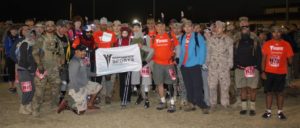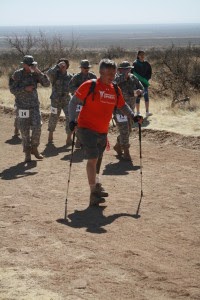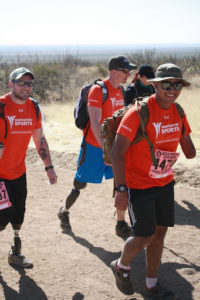An Ode to Those Who Finish Last
By Carol Harnett

I completed another Bataan Memorial Death March yesterday at White Sands Missile Base, New Mexico. It took 13 hours and 13 minutes for my partners and me to complete the course.
When you finish among the last – as I’ve done in three of the four Bataan marathons I participated in since 2010 – you have plenty of time to make observations. Before the soreness creeps out of my calves, I wanted to capture and share some of those thoughts.
Failure can be praiseworthy.
It seems the antithesis of the American way to applaud a last-place finish. Throughout our lives we largely praise those who finish first – and occasionally penalize people who come in last.
It starts innocently enough during our school years with honor rolls, valedictorian addresses and scholarships, and continues into the workplace where employees are often “racked-and-stacked” and then promoted – or not. While A students and top-ranked workers are sometimes teased or envied, I can’t think of anyone who cherishes a C-level status.
But, in the same spirit of expressions such as: “ ‘Tis better to have loved and lost than never to have loved at all,” failure indicates you – at minimum – tried to do something. You chose a school, or a class, or a job, or an event that was somewhat out of your reach.
And, sometimes, simply trying is a badge of honor.
If you click onto the Bataan Memorial Death March website, you will find tabs, including the “Surviving Bataan” section, and advice such as: “This is a rigorous and demanding event. You should be in good health to participate.”
The site goes on to describe what some consider to be the toughest marathon in America – with a grueling terrain that puts participants through wide swings in temperature, challenges associated with altitude and a 1000-foot gain in altitude, a route that is at least 50 percent sand and hard-packed soil, and the infamous, unpredictable winds that usually get worse as the day grows long.
While I admire the men and women who set course records, I cherish those who sign up, train, show up, and are a little fearful of what the course will do to them. In fact, this year, only slightly more than 50 percent of those who stepped off into the desert finished the event.

Therefore, completing something that few people attempt and even fewer finish is noteworthy.
As for this year’s finish, I need to briefly describe the last nine miles or so. When you slowly drift to the back of the pack, you can’t help but notice those who disappear and re-appear around you.
In my case, I was walking with Kirk Bauer, the executive director of Disabled Sports USA and a 60-plus-year-old above-the-knee amputee, and my friend, Tracie Foster, an industry-expert in disability insurance product design. We knew when we accepted the privilege of hiking with our friend, Kirk, that a few things could happen: we would walk slowly, we would be out on the course for 13 or more hours, and we might not be allowed to finish since the event officially closes at the 13-hour mark.
Bauer’s annual determination to summon the internal strength necessary to overcome the course is worthy of its own article, so let me leave my description of his resolve to this sound bite. Never have I seen anyone else walk so close to the edge of a cliff multiple times and, instead of giving in to defeat, literally sprint to the finish line.
Those around us, however, each had their own stories. Certainly, three of our wounded warriors who were at the Bataan marathon as part of DSUSA’s Warfighter Sports’ program stole the show. Two were bilateral leg amputees and the other, like Bauer, was an above-the-knee amputee. One had only worn his prosthetic limb for three weeks prior to the marathon. The courage and intestinal fortitude they demonstrated as they crossed the finish line with Bauer brought tears to the eyes of all. Rarely do you get to witness a storybook ending in person.
But, as we counted the miles down until the finish, we had a series of conversations with people who had their own stories. Two women, in particular, stand out in my mind. We never traded names, but they exchanged quips with us – saying that each time they thought they’d secured their lead, we’d sprint past them.
I looked behind me about a minute after we crossed the finish line to the great fanfare the wounded warriors deserved. There the women were standing; quietly surrounded by a huge embrace from their loved ones. Their ending was no less heroic than those who crossed before them.
There was one surprise at the 26.2-mile mark this year. The base commander, Major General Gwen Bingham and her husband, Patrick, who each completed the 14.2-mile honorary and 26.2-mile full marathon, respectively, were waiting for us about 50 kilometers before the termination point. No other general had done that in my three prior late-day finishes.

And a leader who supports someone’s attempt to finish the near-impossible is a rare and respected find.
I’ve had the tremendous privilege to meet a number of high-ranking military leaders over the last decade due to my involvement with Disabled Sports USA and their Warfighter Sports initiative. Never before have I admired, respected and enjoyed speaking with and observing a leader as much as I have with Major General Bingham. Corporate CEOs should take note of her ability to command and support excellence, including from those who are the last to complete a mission.
So, here’s to those who finish last – and to those who stay to cheer them on. I am proud to be counted among your ranks.

